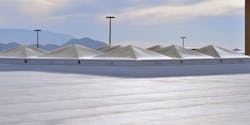The energy performance of cool roofs has been clearly demonstrated in both the lab and in utility bills for buildings that have them, and they also help keep urban areas cooler by reflecting sunlight. Research at the Department of Energy’s Lawrence Berkeley National Laboratory now suggests that widespread adoption of cool roofs can also reduce the quantity of water needed for urban irrigation.
for irrigation by up to 9% in some areas.
Berkeley Lab researchers Pouya Vahmani and Andrew Jones used regional climate simulations of 18 California counties to find that cool roofs could reduce water consumption by as much as 9% if implemented widely. The study, which appeared in Nature Communications, suggests that in Los Angeles County alone, water savings from irrigation could reach 83 million gallons per day if all buildings had reflective roofs.
Related: ASTM Standard Addresses Green Roof Water Management
“This is the first study to look at the link between water and heat mitigation strategies in urban areas,” says Vahmani. “You might not do cool roofs just to save water, but it’s another previously unrecognized benefit of having cool roofs. And from a water management standpoint, it’s an entirely different way of thinking – to manipulate the local climate in order to manipulate water demand.”
By reducing the ambient air temperature by 1.8-2.7 degrees F. in the study, cool roofs reduce water consumption because lawns and other landscaping need less water, according to the study. The scientists also contend that modification of human behavior may be needed to fully realize this water saving potential.
“There is a key assumption in here that people would adjust their irrigation behavior in response,” says Jones. “In order to reap the benefits, we would need people to be aware of the appropriate amount of water or use sensors or smart irrigation systems, which are a good idea anyway.”
Their research suggested that the water savings were stronger on hotter days, explains Jones: “So that’s an indication that in a future climate, where hot days are occurring much more frequently, the added benefit of doing cool roofs might be even more dramatic. But that has yet to be investigated.”
Weather Model Analysis
For the research, the scientists used a high-resolution regional climate model to which Vahmani added a component to account for irrigation. “It basically adjusts soil moisture to mimic irrigation events,” Vahmani explains. “We also used remote sensing data to improve the representation of physical characteristics of the land surface, which resulted in improved model performance.”
The researchers then validated their model with data from Northern California’s Contra Costa Water District for their irrigation-only customers. Simulations with the model were run over 15 years in 18 counties throughout California and assumed a control scenario reflecting the status of urban areas and a scenario in which buildings had commercially available cool roofs installed.
Even more: Cut Costs with Cool Roofs
Irrigation savings countywide ranged from 4-9%, and medium density environments (those with a mix of buildings and landscaping) saw the highest reductions in water use.
Offsetting Cooling Effects
While the study yielded positive conclusions about how cooling can reduce irrigation, they also found that changing irrigation habits could significantly affect temperatures.
Water conservation measures designed to directly reduce irrigation, e.g. drought-tolerant landscaping, can unintentionally increase urban temperatures. In one simulation, Vahmani and Jones tested the effects of completely cutting off irrigation and found a mean daytime warming of 1 degree C. on average over the San Francisco Bay Area.
“These results show that the warming signal from strategies that focus only on outdoor water-use reductions can meaningfully offset the cooling effects of a major heat mitigation strategy, such as citywide cool roof deployment,” they write.
Justin Feit was associate editor for BUILDINGS.
